 |
|
  04.12.03 04.12.03
click to enlarge
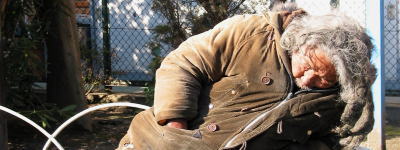
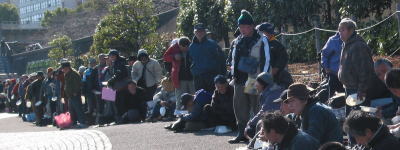
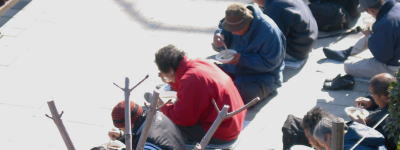
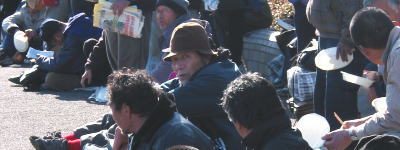
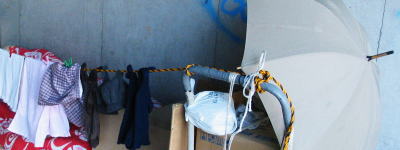
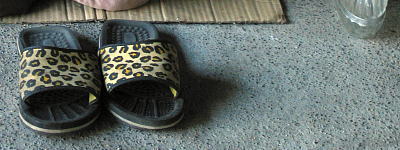
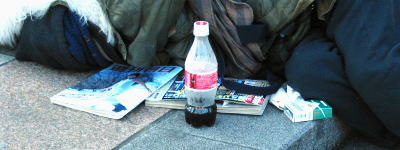
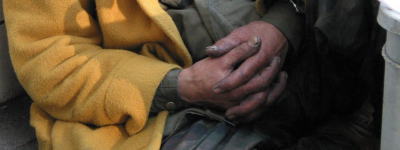
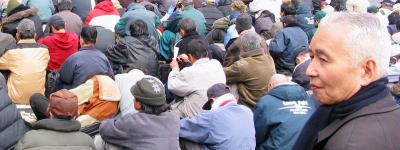
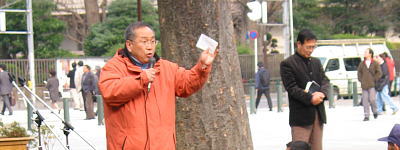
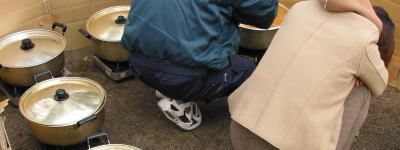
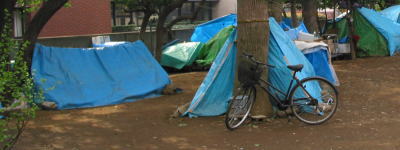
I've heard it said that homelessness is on
the rise in Tokyo, and casual observation
would seem to verify that claim. If you go
to any of the major parks, or look under
some of the larger raised expressways, you'll
find countless little makeshift dwellings
made from scrapwood, cardboard, and blue
vinyl tarps. These 'blue tarp' villages seem
to be getting larger all of the time.
Tokyo, like any other city, has its share
of mentally ill and drug-addicted street
bums covered in grime and filth (though not
really so many), but unlike most places that
I know of there are thousands of 'socially
functional' homeless people living just outside
the periphery of society.
These socially functional homeless people
are the ones who build the neat little blue-tarp
homes. They often do some kind of work, even
if it's just collecting cardboard or cans
for recycling, and keep their homes and themselves
relatively neat and clean.
If you walk through one of these blue-tarped
villages you'll often see the men sitting
around in groups playing chess, drinking
beer, and listening to music. Many of the
shelters will have cook stoves and bedding.
You'll see that a lot of them even have alarm
clocks.
I can't really say what the socioeconomic
factors that led to this state of affairs
is. No doubt the increase in homelessness
is related to the declinining economy and
restructing of the work force. However, I
also suspect that other non-economic social
factors play a significant role. It seems
that, at least for some people, this form
of homelessness is a way of just dropping
out of society.
  04.09.03 04.09.03
click to enlarge
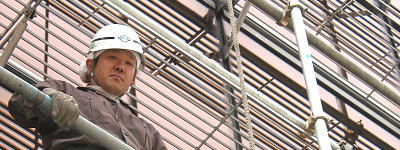
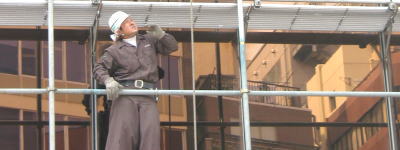
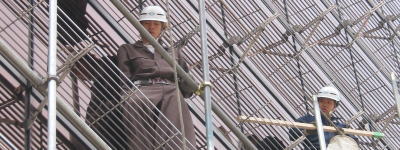
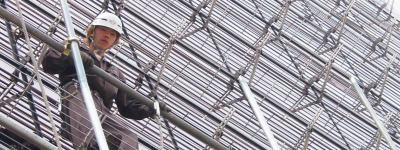
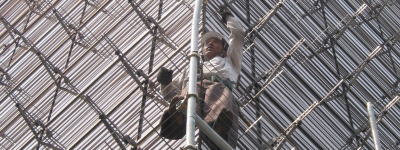
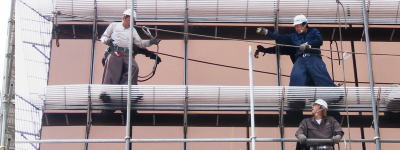
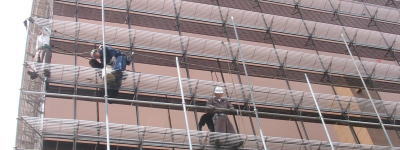
I was just getting ready to go to bed and
as I stood there taking my shirt off and
looking out the apartment window I heard
the staccato dack-dack-dack of a jack-hammer and I thought to myself
'here we go again -- more construction.'
My neighbourhood, Minami Senju, is where
construction projects go when they die --
it is Valhalla for construction projects;
it is the land of never-ending building noise.
I don't know why there is so much construction
going on around here, but it seems to go
in cycles. Everywhere you go, they're digging
ditches and drilling holes. You see front-end
loaders and cement trucks whizzing back and
forth along the small side streets. The silhouettes
of construction cranes dot the horizon like
trees along a distant mountain ridge.
We've been living here in our apartment for
about two and a half years. It's an okay
place, and large by Tokyo standards. The
catch is, two sets of train tracks run by
the base of the building, so there's a lot
of train noise.
We've gotten used to the trains, but what
has been boggling our minds is that the city
has been building a third set of tracks parallel
to the original two ever since we've moved
in, and even now they don't seem to be anywhere
close to being finished. And apparently,
the manager of the construction company feels
that drills and jack-hammers function better
very late at night, because that's they only
time that they're used.
With so much heavy work going on in the neighbourhood
I've had a chance to make a few observations
about Japanese construction sites and construction
workers.
First of all, they keep their work sites
and construction equipment in immaculate
condition. Every backhoe, crane, and loader
is kept spotless and they always look brand
new. The construction site is never cluttered,
and on the larger sites one of the first
things they do is 'pave' the site with large
steel plates so that the dirt doesn't get
churned up into mud and spread everywhere.
The construction crews seem to have a lot
of meetings, and sometimes after the morning
meeting they will do calisthenics. Quite
regularly, they will all walk through the
neigbourhood around the construction site
and pick up all of the litter (not that there's
ever much of it), right down to the cigarette
butts. I guess that's their way of staying
in good stead with the local residents.
I've only every seen men working on construction
crews, and just like back in Canada, they
seem to be rough guys -- often unshaved and
in need of hair cuts. However, they take
their appearance seriously, and just like
most other professions in Japan, they have
a dress code.
You never see anyone just wearing a pair
of jeans -- they always have on proper work
clothes, usually very baggy pants cinched
tight around the angles with a matching jacket.
Sometimes they'll also wear the traditional
split-toe, canvas boots. They also seem to
take hard hat wearing very seriously -- I've
never seen anyone even remotely associated
with a work site, such as street crossing
guards, not wear a proper helmet.
So that's what I've noticed about Japanese
construction sites. Now it's time to really
go to bed. I think the jack-hammer guy must
be taking a smoke break because I can't hear
him anymore. However, he'll be back soon.
He always is.
  04.06.03 04.06.03
click to enlarge
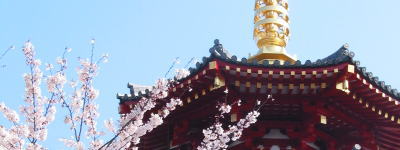
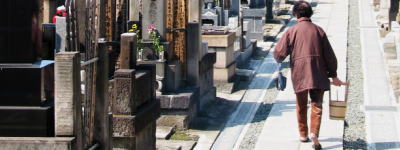
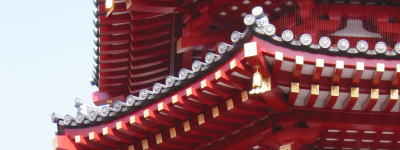
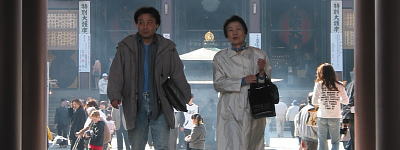
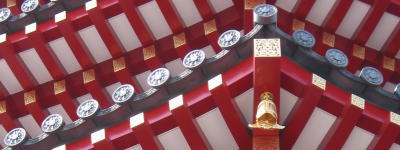
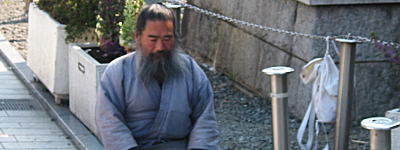
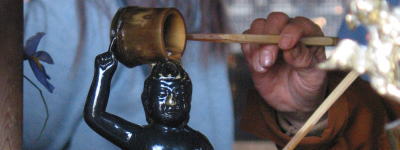
Just a quick update for you today.
Tomorrow I'm going back to Japanese language
school after a two week hiatus. I had so
many plans for my holiday, so many chores
I was going to complete, but somehow I managed
to get practically nothing done. Sometimes
I just don't know where the time goes.
Today's pictures are from Kanayama Shrine
in Kawasaki. We went there today because
there was a fertility festival where they
parade giant phalli through the streets,
unfortunately we got there too late and missed
the parade. So, I guess you're just stuck
with some pictures of the pagoda. Yaawwwn
... I know.
---------------------------
I wish I had gone to this parade instead -- happy birthday Astro Boy.
  04.03.03 04.03.03
click to enlarge
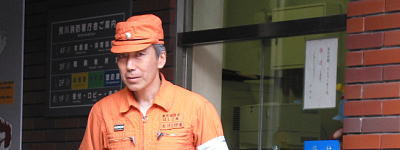
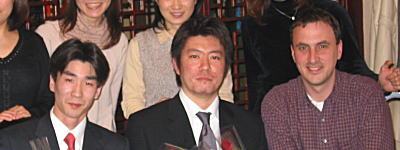
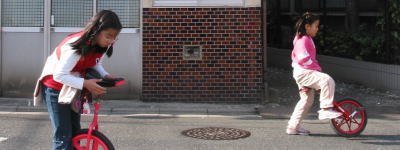


You may have read here earlier that I took
a new part-time job conducting Christian
weddings on the weekends. This past Sunday
I did my first wedding. Here's how it went.
The ceremony, as is typical, took place in
a hotel chapel. The hotel was in Omori, which,
if you know Tokyo at all, is close to Kawasaki
-- not exactly the nicest part of town. The
hotel was nothing fancy, but the chapel,
a separate little structure abutting the
main building, was quite well kept up. It
had a cast iron bell out front, ten rows
of pews, a raised stage, an organ, and, of
course, a big cross up on the wall behind
the podium.
I wasn't there alone. With me were two choirgirls
and an organist, all of us from the same
wedding company. The choirgirls do all the
real work -- they usually have years of experience
with these weddings, and because they're
native Japanese speakers, they're the ones
who give the bulk of the ceremony instructions
to the couple during the rehearsal.
The entire event lasts for about 30 minutes,
and that's including the 10 minutes for the
rehearsal which takes place just before the
real ceremony. So, that means the actual
ceremony is only about 20 minutes long.
This is how it all proceeded.
As arranged, I met with the choir members
in front of the hotel one hour before the
wedding was due to begin. Using the servant's
entrance, we went to the front desk, picked
up a room key that was waiting for us, took
the elevator up to room 305, and changed
into our vestments. When we all had our robes
and stoles on we went down to the chapel
together and were greeted by the hotel representative,
a young guy in a tuxedo who smiled broadly
but seemed exceedingly bored.
I stood up on the stage behind the podium
and after a few moments the couple was brought
out in front of me. They were young. The
groom was in his early twenties, had his
hair dyed brown and was wearing a grey tuxedo
with tails. The bride was pretty and had
on the full white gown with lacey veil and
billowing skirt. I congratulated them, told
them my name, and then checked the pronunciation
of their names. Then, with the choirgirls
doing most of the talking, we all quickly
walked through the steps of the ceremony.
When we were done, the couple was lead out,
and a few minutes later the guests started
to file in and take their seats. The left
side of the chapel was for the bride's friends
and family and the right side for the groom's.
The groom had a lot of his buddies there,
they all looked kind of rough and awkward
in their rented tuxedos. Conversely, the
bride had a lot of young girl friends there
in beautiful long flowing dresses. Both the
mother of the bride and the mother of the
groom were wearing formal kimono. The groom's
sister
was dressed in
a beautiful bright orange kimono embroidered
with scenes of cranes and willow trees on
a riverbank.
As I looked around at all the guests I really
started to get nervous. All of a sudden,
my mouth felt as dry as an Iraqi sandstorm.
The bored-looking hotel man, standing at
the opposite side of the hall by the main
door, gave me a nod and that was my queue
to begin the ceremony.
In both English and Japanese I greeted the
guests, told them my name, and then asked
them all to stand up and to look towards
the door to watch the bride's entrance.
The doors opened, and there, framed by the
sunlight, was the young bride holding the
arm of her father. The organist began playing:
DUM DUM DA DUM, DUM DUM DA DUM..., and they
began to walk towards me. A rush of excitement
came up from the pit of my stomach and stuck
in my throat. I couldn't stop smiling at
the thought of where I was and what I was
doing. The bride was radiant in her contained,
smiling, nervousness. About three-quarters
of the way down the aisle, the groom stepped
out and bowed deeply to the father, who then
handed the bride to the groom. In a few more
steps they were both standing right in front
of me, all wide-eyed, sweaty, and nervous.
The organist stopped, and all of a sudden
all eyes were on me. I swallowed hard, looked
down at my script and said: "Sanbika 312 o sanbi shimasu (we will now sing hymn number 312)".
Everyone immediately started grumbling, I
froze for a second, then, out of the corner
of my eye I saw the senior choir girl gesticulating
wildly with one hand: I had forgotten to
tell everyone to sit down! So, with as much
grace and nonchalance as I could muster,
I asked everyone to sit down (mina-san osuwari
kudasai), and then we all sang two verses
of 'You've got a friend in Jesus' in Japanese.
When we finished singing, I announced my
bible reading: "Shinyaku Seisho, daiichi korinto juusan shou
wo, oyomi shimasu (Bible Reading of 1st Corinthians chapter
13). It goes, "Ai wa kanyou deari, Ai wa shinsetsu
desu,...", telling about how Love is kind and not
jealous.
Next, I gave my 'personal' message to the
couple:
"Kono
ai wa, kami no ai, ataeru ai desu. Watashitachi
no kekkon seikatsu ni...", and it goes
on about God's love and Jesus' love, and
how they should accept all of this divine
love. About halfway through my message I
stumbled over a few hard-to-pronounce words
and a bunch of the groom's friends
started to snicker and laugh. This threw
my rhythm off a bit, but I just kept on going.
Then came the exchange of vows: "Seiyaku wo onegai shimasu". I felt a lot of pressure for this
part because I had to have it completely
memorized. It went well. As is usual in Japanese
grammar, the question word is at the end
of the sentence (chikaimasu ka?), and the bride and groom, instead of saying
'I do', say 'Hai. Chikaimasu'.
Next came the exchange of rings. I had the
rings beside me on a little white, heart-shaped
cushion edged in lace. I picked up the smallest
ring, held it up in the air like I was saying
a quick prayer, and handed it to the groom.
Then, I did the same thing for the bride.
In his nervousness, the groom then went to
lift up the bride's veil to give her a kiss.
The choir members nearly jumped out of their
seats, but I stopped him in time and quietly
told him "not yet", however, people
still noticed his mistake and he had to endure
the giggles and sniggers from
his friends in the back pew.
The next step in the ceremony was the signing
of the wedding certificate. This was kept
in a small blue velvet booklet and placed
on a stand to the left of the podium. After
I took the groom's gloves and a choir member
took the bride's bouquet, we all stepped
up to the certificate and I watched the couple
sign. I had presigned it before the ceremony.
We returned to our original places, I asked
the couple to put their hands on the Bible,
then I raised my hands in the air and said
the one and only English prayer of the entire
ceremony: "Heavenly Father, please send
your blessing upon this man and this woman
whom we bless in your name, so these persons
may keep their vow and remain in perfect love
and peace together. We ask you in Jesus Christ.
Amen!"
After they took their hands off the Bible,
I again put my hands in the air and did the
prouncement: "Ofutari wa, kami to minasan to no mae de,...(I now pronounce you man and wife).
I told them they could now do their wedding
kiss. The bride, as she was instructed, then
did a slow and graceful kind of curtsey and
the groom lifted her veil. He then gave her
a light kiss on the lips.
I shouted out "Ometedou gozaimasu (congratulations)".
The ceremony was now winding down. I asked
everyone to stand up again and then we all
sang another hymn. After the hymn I once
again raised my arms in the air and this
time I did a benediction.
Finally, I told the couple to turn around
and to commence their recessional. As they
slowly marched out I began to clap loudly
and everyone else followed suit. In a few
moments they were out the door, and then
I told everyone to sit down and then thanked
them for coming.
|
|
|
 |


22 comments so far